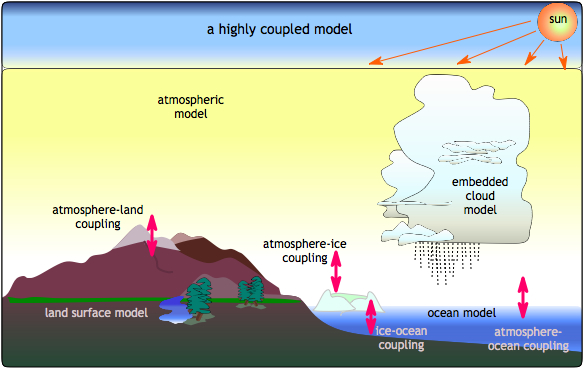
|

|


What Improvements do Models Need to be More Accurate?
Interactions with other parts of the Earth system
 Climate models can be more realistic by exchanging information with models that
represent the ocean, land surface, hydrology, vegetation cover, sea ice extent,
atmospheric chemistry and other processes. When we combine a climate model with
a code that models the ocean or land surface or other Earth process, the
resulting model is called a Coupled Model
. Let's talk about some of these.
Just like two heads are better than one, two models are better than one.
The coupled models are better able to represent realistic processes and
interactions between the atmosphere and other parts of the earth system than
either one on its own.
For example, land surface models predict conditions on the continents. If they
are coupled to a GCM, they will get information like radiation, cloud cover, and
amount of rainfall from the GCM. In turn, they give the GCM information about
the temperature and fluxes of heat and moisture from the surface. Land surface
models also can calculate more than just the weather. They can represent
different kinds of vegetation, which undergoes
photosynthesis
and respiration and allows modelers to study the
flow of carbon
between the atmosphere and the
biosphere.
The Denning research group at CMMAP is studying land surface.
Here is a link to
their research website.
Studying these interactions is crucial in the face of global climate change and
increasing levels of
atmospheric carbon
dioxide.
Next page
->
improvements, continued
Climate models can be more realistic by exchanging information with models that
represent the ocean, land surface, hydrology, vegetation cover, sea ice extent,
atmospheric chemistry and other processes. When we combine a climate model with
a code that models the ocean or land surface or other Earth process, the
resulting model is called a Coupled Model
. Let's talk about some of these.
Just like two heads are better than one, two models are better than one.
The coupled models are better able to represent realistic processes and
interactions between the atmosphere and other parts of the earth system than
either one on its own.
For example, land surface models predict conditions on the continents. If they
are coupled to a GCM, they will get information like radiation, cloud cover, and
amount of rainfall from the GCM. In turn, they give the GCM information about
the temperature and fluxes of heat and moisture from the surface. Land surface
models also can calculate more than just the weather. They can represent
different kinds of vegetation, which undergoes
photosynthesis
and respiration and allows modelers to study the
flow of carbon
between the atmosphere and the
biosphere.
The Denning research group at CMMAP is studying land surface.
Here is a link to
their research website.
Studying these interactions is crucial in the face of global climate change and
increasing levels of
atmospheric carbon
dioxide.
Next page
->
improvements, continued
Links and resources
Interactions with other parts of the Earth system
 Climate models can be more realistic by exchanging information with models that
represent the ocean, land surface, hydrology, vegetation cover, sea ice extent,
atmospheric chemistry and other processes. When we combine a climate model with
a code that models the ocean or land surface or other Earth process, the
resulting model is called a Coupled Model
. Let's talk about some of these.
Just like two heads are better than one, two models are better than one.
The coupled models are better able to represent realistic processes and
interactions between the atmosphere and other parts of the earth system than
either one on its own.
For example, land surface models predict conditions on the continents. If they
are coupled to a GCM, they will get information like radiation, cloud cover, and
amount of rainfall from the GCM. In turn, they give the GCM information about
the temperature and fluxes of heat and moisture from the surface. Land surface
models also can calculate more than just the weather. They can represent
different kinds of vegetation, which undergoes
photosynthesis
and respiration and allows modelers to study the
flow of carbon
between the atmosphere and the
biosphere.
The Denning research group at CMMAP is studying land surface.
Here is a link to
their research website.
Studying these interactions is crucial in the face of global climate change and
increasing levels of
atmospheric carbon
dioxide.
Next page
->
improvements, continued
Climate models can be more realistic by exchanging information with models that
represent the ocean, land surface, hydrology, vegetation cover, sea ice extent,
atmospheric chemistry and other processes. When we combine a climate model with
a code that models the ocean or land surface or other Earth process, the
resulting model is called a Coupled Model
. Let's talk about some of these.
Just like two heads are better than one, two models are better than one.
The coupled models are better able to represent realistic processes and
interactions between the atmosphere and other parts of the earth system than
either one on its own.
For example, land surface models predict conditions on the continents. If they
are coupled to a GCM, they will get information like radiation, cloud cover, and
amount of rainfall from the GCM. In turn, they give the GCM information about
the temperature and fluxes of heat and moisture from the surface. Land surface
models also can calculate more than just the weather. They can represent
different kinds of vegetation, which undergoes
photosynthesis
and respiration and allows modelers to study the
flow of carbon
between the atmosphere and the
biosphere.
The Denning research group at CMMAP is studying land surface.
Here is a link to
their research website.
Studying these interactions is crucial in the face of global climate change and
increasing levels of
atmospheric carbon
dioxide.
Next page
->
improvements, continuedLinks and resources
